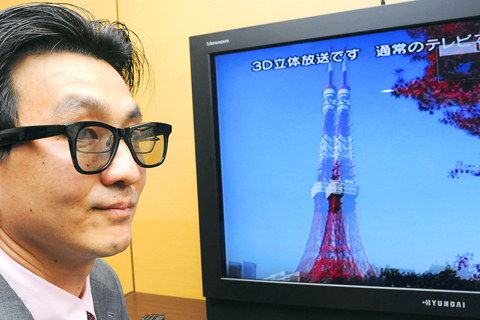Badminton matches look so real playing on Hyundai’s new 3D TV that you may reflexively dodge the shuttlecock. A polar bear pawing the glass of his tank may seem to be inside the TV pushing on the screen.
Hyundai is offering — in Japan only — the first product for watching the 3D programs that cable stations in Japan now broadcast about four times a day.
PRICEY HOBBY

PHOTO: AP
There are, however, a few catches.
The 46-inch liquid-crystal display requires 3D glasses; it’s expensive — US$3,960, including two pairs of glasses, or about 25 percent more than a comparable regular LCD TV; and the only programs available so far include just a few minutes of video from Japan’s northern island of Hokkaido — shots from the zoo, motorcycle-races and other short scenes.
PLAIN OLD TV
Seen on regular TVs, 3D programs split the screen vertically so the same image appears in both the left and right halves.
Conversely, wearing the 3D glasses while watching regular programming on the Hyundai 3D TV produces a slight 3D effect.
The TV uses stereoscopic technology called TriDef from DDD Group Plc in Santa Monica, California, which works by sending the same image separately for the left eye and the right eye.
Ryo Saito of BS 11, the cable channel that runs the 3D shows, says more content is needed for the technology to catch on, and other manufacturers need to start making 3D televisions.
“People are showing interest in 3D programs, but most homes don’t have the special TVs,” he said.
SAMSUNG
Samsung already sells 3D rear projection TVs in the US, but there are no 3D TV broadcasts in the US. The technology is also available on desktop monitors and for video games.
Hyundai IT is hoping to boost its image by gaining a niche audience in Japan, where the TV market is dominated by Sony Corp and Sharp Corp. The South Korean electronics maker’s 3D TV went on sale in April, but unit sales numbers weren’t available.
There is no plan to sell the TV overseas, Hyundai Japan senior manager Kim Pyeng-joong said.

LONG FLIGHT: The jets would be flown by US pilots, with Taiwanese copilots in the two-seat F-16D variant to help familiarize them with the aircraft, the source said The US is expected to fly 10 Lockheed Martin F-16C/D Block 70/72 jets to Taiwan over the coming months to fulfill a long-awaited order of 66 aircraft, a defense official said yesterday. Word that the first batch of the jets would be delivered soon was welcome news to Taiwan, which has become concerned about delays in the delivery of US arms amid rising military tensions with China. Speaking on condition of anonymity, the official said the initial tranche of the nation’s F-16s are rolling off assembly lines in the US and would be flown under their own power to Taiwan by way

OBJECTS AT SEA: Satellites with synthetic-aperture radar could aid in the detection of small Chinese boats attempting to illegally enter Taiwan, the space agency head said Taiwan aims to send the nation’s first low Earth orbit (LEO) satellite into space in 2027, while the first Formosat-8 and Formosat-9 spacecraft are to be launched in October and 2028 respectively, the National Science and Technology Council said yesterday. The council laid out its space development plan in a report reviewed by members of the legislature’s Education and Culture Committee. Six LEO satellites would be produced in the initial phase, with the first one, the B5G-1A, scheduled to be launched in 2027, the council said in the report. Regarding the second satellite, the B5G-1B, the government plans to work with private contractors

MISSION: The Indo-Pacific region is ‘the priority theater,’ where the task of deterrence extends across the entire region, including Taiwan, the US Pacific Fleet commander said The US Navy’s “mission of deterrence” in the Indo-Pacific theater applies to Taiwan, Pacific Fleet Commander Admiral Stephen Koehler told the South China Sea Conference on Tuesday. The conference, organized by the Center for Strategic and International Studies (CSIS), is an international platform for senior officials and experts from countries with security interests in the region. “The Pacific Fleet’s mission is to deter aggression across the Western Pacific, together with our allies and partners, and to prevail in combat if necessary, Koehler said in the event’s keynote speech. “That mission of deterrence applies regionwide — including the South China Sea and Taiwan,” he

‘NARWHAL’: The indigenous submarine completed its harbor acceptance test recently and is now under heavy guard as it undergoes tests in open waters, a source said The Hai Kun (海鯤), the nation’s first indigenous defense submarine, yesterday began sea trials, sailing out of the Port of Kaohsiung, a military source said. Also known as the “Narwhal,” the vessel departed from CSBC Corp, Taiwan’s (台灣國際造船) shipyard at about 8am, where it had been docked. More than 10 technicians and military personnel were on deck, with several others standing atop the sail. After recently completing its harbor acceptance test, the vessel has started a series of sea-based trials, including tests of its propulsion and navigational systems, while partially surfaced, the source said. The Hai Kun underwent tests in the port from